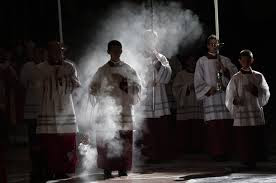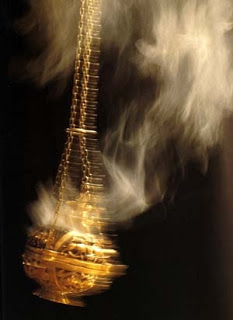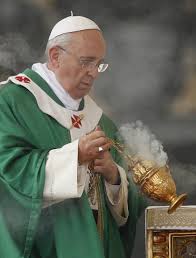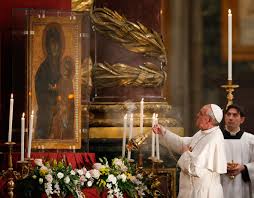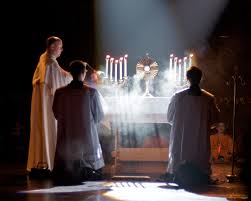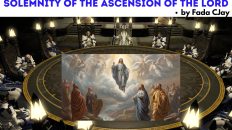– Significance of Incense
– Incense in the Old and New Testament
– Incense at Liturgical Celebrations (Mass, Funerals, Benediction etc)
The word “incense” is derived from the Latin incendere, which means “to burn”.
It is commonly used as a noun to describe aromatic matter that releases
fragrant smoke when ignited, to describe the smoke itself, and as a verb to
describe the process of distributing the smoke.
Actually, the use of incense is an expression of prayer, and it is in fact very
scriptural, very Roman Catholic, and very Judeo-Christian. There is a recipe
for incense in Exodus (30: 34-36), and incense is associated with divinity and
reserved for God (Ex: 30: 37-38).
things and people. In the scriptures, ritual incensing of objects, people and
places was for their purification or for making the object or person holy and
worthy of God. So the purpose of incensing and the symbolic value of the smoke
is that of prayer, blessing, purification, and sanctification.
We read in Sacred Scripture:
From the farthest east to the farthest west, my name is honored among the
nations and everywhere a sacrifice of incense is offered to my name, and a pure
offering too, since my name is honored among the nations. (Malachi 1:11)
(Psalm 141)
As Catholics, we express our worship of Almighty God in words and gestures.
Burning of incense is a prayer in itself; a prayer in action. Furthermore, for
Catholics prayer is action, and that action becomes ever more present through
the visual and sensual experience of incense.
the faithful drifting up to heaven, incense actually creates the AMBIANCE of
HEAVEN. The Book of Revelation describes the heavenly worship as follows:
“Another angel came in holding a censer of gold. He took his place at the
altar of incense and was given large amounts of incense to deposit on the altar
of gold in front of the throne, together with the prayers of all God’s holy
ones. From the angel’s hand, the smoke of the incense went up before God, and
with it the prayers of God’s people.” Hence, incense connects us to God’s
altar in heaven and allows us to utilize all of our senses in our prayer.
mystery to the Mass. The visual imagery of the smoke and the smell remind us of
the transcendence of the Mass which links heaven with earth, and allows us to
enter into the presence of God. We are called to be solemn during Mass, not
somber –there is a big difference! It helps us to understand that at Mass we
enter into and are united with the worship offered God in Heaven by His Angels
and Saints. If we are told, after all, that the angels stand amid clouds of
incense singing God’s praise in heaven, why shouldn’t they do the same gathered
around the altar, as they are, singing God’s praise during the Holy Sacrifice
of the Mass?
According to the General Instruction of the Roman Missal incense may be used
during the entrance procession; at the beginning of Mass, to incense the altar;
at the procession and proclamation of the Gospel; at the offertory, to incense
the offerings, altar, priest and people; and at the elevation of the Sacred
Host and chalice of Precious Blood after the consecration.
The Altar represents Christ and his five wounds. when we incense the altar at
the beginning of the Holy Sacrifice of the Mass, we directly connect with
Christ’s Holy Sacrifice, for this is Christ’s Altar of sacrifice containing his
five wounds upon which his precious body and blood will be offered.
What are we expressing with this incensing of the Gospel Book? It is a sign of
devotion toward these holy words of and about our Savior, which have been
preserved for nearly 2000 years, in reverence and love. Catholics firmly
believe Christ is present in His word proclaimed, and so we bless and honor
that Word who will imminently be present through His words, the Holy Gospel. As
the sweet smoke (always first blessed by the priest) rises toward and surrounds
the holy book, we are acknowledging: these are the words that God spoke when He
became man and walked on this earth; this is the story of our salvation; here
is the promise of everlasting life; here is the testimony of God’s love for us.
During the offertory (the preparation of the gifts) incense is used:
1) To bless and to pray for the purification of the the bread and wine as well
as the spiritual gifts the people have mentally placed on the altar. We offer
all our prayers, our joys, our needs, our grief, as well as our sacrifice of
praise and thanksgiving.
purification and sanctification of the priest and the congregation. So as the
priest and deacon prepare the gifts, the people are also properly prepared and
blessed. The incense is pure myrrh which the women carried when they went to
the tomb to anoint Jesus’ body. So in a very real sense when we are incensed
during Mass our bodies have been anointed with the myrrh, and we ourselves have
become a purified offering to God as we offer our gifts, our spiritual
sacrifices, our bodies, our entire being to God through His Son Jesus Christ
who will soon become present on the Altar.
offering of prayer in action, all through incense, we are all now standing as
the priest says : Pray brothers and sisters that our sacrifice (everything we
have just blessed) may be acceptable to God the Almighty Father.
During the consecration, the thurifer moves into place during the Sanctus
(Holy, Holy, Holy) and remain in a kneeling position until the Great Amen. The
proper protocol for this would be incense only when the celebrating priest
elevates the consecrated host or chalice. This gives a sense of our special
reverence for the Eucharist, and the importance of the Eucharist to our prayer
life, for incense is prayer in action.
The priest may also incense the Crucifix and the Paschal Candle. During funeral
Masses, the priest at the final commendation may incense the coffin, for two
reasons:
1) As a sign of honor to the body of the deceased which became the temple of
the Holy Spirit at Baptism. That is a very important concept for Catholics.
When the women went to the tomb to anoint Jesus Body they took with them myrrh.
The incense made from pure myrrh gives honor to the dignity of the human body
especially when considered in the context of the women at the tomb.
2) As a sensual sign of the faithful’s prayers for the deceased rising to God.
It is that beautiful sign of prayer in action.
Eucharistic processions:
It is Christ whom we honor in Eucharistic Adoration and Christ whom we follow
in a Eucharistic procession.
golden censer; and he was given much incense to mingle with the prayers of all
the saints upon the golden altar before the throne. And the smoke of the
incense rose with the prayers of the saints from the hand of the angel before
God”
(Rev. 8:3-4).
So let our prayer rise like incense, and let our incense rise like
prayer, so that in all things God may be glorified…
